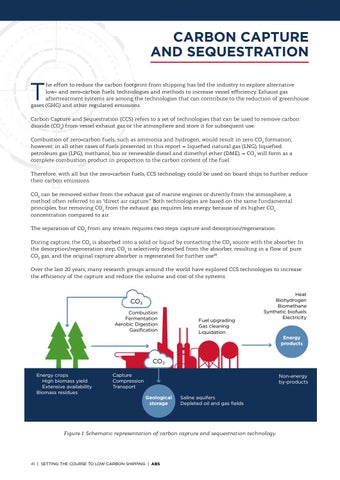CARBON CAPTURE AND SEQUESTRATION
T
he effort to reduce the carbon footprint from shipping has led the industry to explore alternative low- and zero-carbon fuels, technologies and methods to increase vessel efficiency. Exhaust gas aftertreatment systems are among the technologies that can contribute to the reduction of greenhouse gases (GHG) and other regulated emissions. Carbon Capture and Sequestration (CCS) refers to a set of technologies that can be used to remove carbon dioxide (CO2) from vessel exhaust gas or the atmosphere and store it for subsequent use. Combustion of zero-carbon fuels, such as ammonia and hydrogen, would result in zero CO2 formation; however, in all other cases of fuels presented in this report — liquefied natural gas (LNG), liquefied petroleum gas (LPG), methanol, bio or renewable diesel and dimethyl ether (DME), — CO2 will form as a complete combustion product in proportion to the carbon content of the fuel. Therefore, with all but the zero-carbon fuels, CCS technology could be used on board ships to further reduce their carbon emissions. CO2 can be removed either from the exhaust gas of marine engines or directly from the atmosphere, a method often referred to as “direct air capture.” Both technologies are based on the same fundamental principles, but removing CO2 from the exhaust gas requires less energy because of its higher CO2 concentration compared to air. The separation of CO2 from any stream requires two steps: capture and desorption/regeneration. During capture, the CO2 is absorbed into a solid or liquid by contacting the CO2 source with the absorber. In the desorption/regeneration step, CO2 is selectively desorbed from the absorber, resulting in a flow of pure CO2 gas, and the original capture absorber is regenerated for further use33. Over the last 20 years, many research groups around the world have explored CCS technologies to increase the efficiency of the capture and reduce the volume and cost of the systems.
CO2 Combustion Fermentation Aerobic Digestion Gasification
Fuel upgrading Gas cleaning Liquidation
Heat Biohydrogen Biomethane Synthetic biofuels Electricity
Energy products
CO2 Energy crops High biomass yield Extensive availability Biomass residues
Capture Compression Transport
Non-energy by-products Geological storage
Saline aquifers Depleted oil and gas fields
Figure 1: Schematic representation of carbon capture and sequestration technology.
41 | SETTING THE COURSE TO LOW CARBON SHIPPING | ABS
